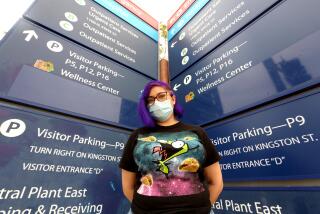Other Hospitals Expect More Patients : St. Joseph Trauma Care Nears End
- Share via
St. Joseph Medical Center in Burbank will formally withdraw from Los Angeles County’s trauma network on Monday, leaving officials from nearby hospitals fearing an increase in the number of critically ill patients they must treat.
“We’re not adding any more staff to handle the expected increase, but psychologically we’re gearing up,” said John McConnellogue, director of the emergency department at Northridge Hospital Medical Center.
Officials for the two other trauma centers closest to St. Joseph, Huntington Memorial Hospital in Pasadena and Holy Cross Medical Center in Mission Hills, also said they are concerned about the effect of the withdrawal on their facilities but were not making special arrangements to handle extra patients.
Administrators at St. Joseph noted that emergency care will still be provided at the facility, principally for Burbank residents.
“We will no longer have a general surgeon on duty 24 hours a day like before,” said Sue Retter, senior assistant administrator for nursing and patient care services. “But we will still have a full basic emergency department. There will be a surgeon on a beeper who will be able to reach the hospital in 20 minutes if the need arises.”
Insufficient Reimbursement
St. Joseph officials announced in April that they were dropping out of the trauma care network, saying the hospital was not being adequately reimbursed by state and federal agencies for providing health services. They said the withdrawal was due to operating expenses and the cost of providing care to an increasing number of indigent patients.
The hospital was losing up to $2 million a year, the officials said.
Eight hospitals have quit the county’s trauma care network since its inception in 1984. Whittier Presbyterian Intercommunity Hospital earlier this month also announced its intention to withdraw from the network.
Trauma centers are designed to treat people suffering critical injuries from auto accidents, falls and violent accidents. Each trauma center in the county network serves a geographical zone and is required to have a neurosurgeon and other specialists on duty 24 hours a day.
“In terms of that area, there will essentially be no trauma care center,” said Virginia Price Hastings, chief of paramedics and trauma hospitals for Los Angeles County. “This area is back in the Dark Ages as far as that is concerned. The bulk of the area will always be more than 20 minutes away from a trauma care center.”
Hastings said the county had held discussions with other trauma care centers to take over all or part of St. Joseph’s zone.
“Those hospitals told us they just can’t take the additional area because of their present patient volume,” she said. “We can’t require them to take on the other patients. Critically injured patients will be taken to the nearest emergency room.”
For instance, patients would be taken to Burbank Community Hospital or other 24-hour emergency rooms, she said.
St. Joseph serves an average of 55 trauma patients a month.
“Even if Northridge Hospital took on a third of that, it would be too much for us to handle,” McConnellogue said. He said the facility treats an average of 46 patients a month.
More to Read
Sign up for Essential California
The most important California stories and recommendations in your inbox every morning.
You may occasionally receive promotional content from the Los Angeles Times.














